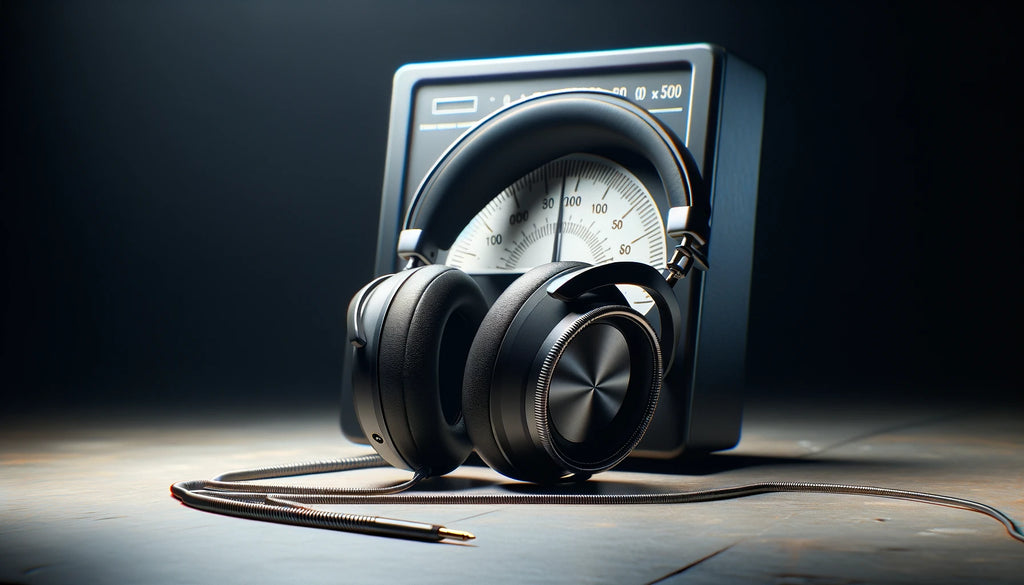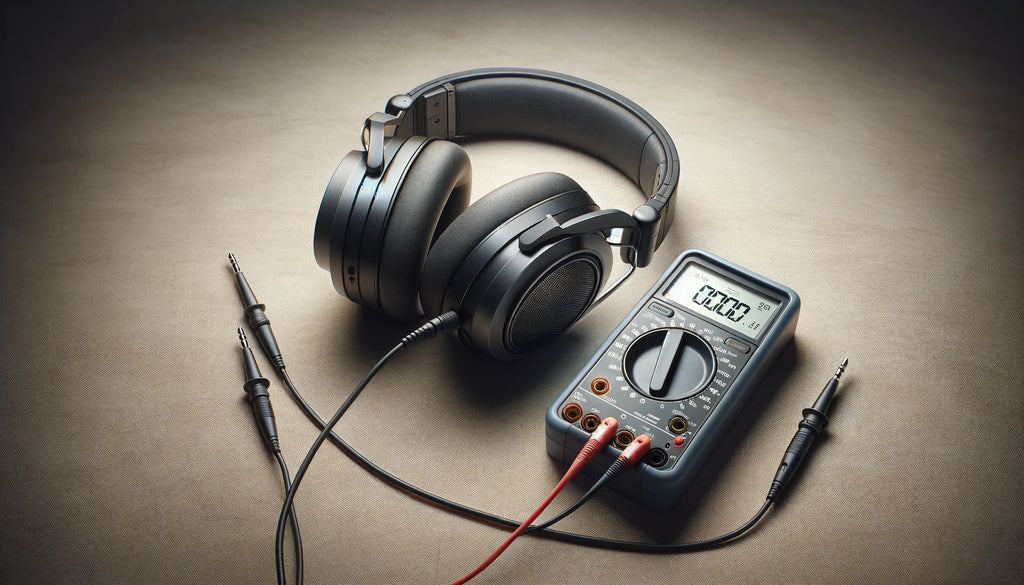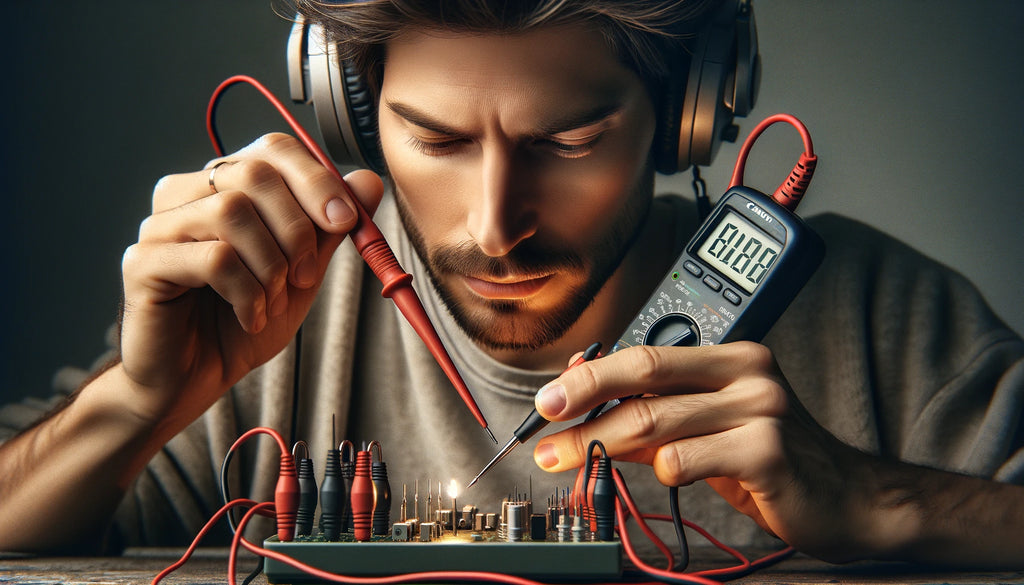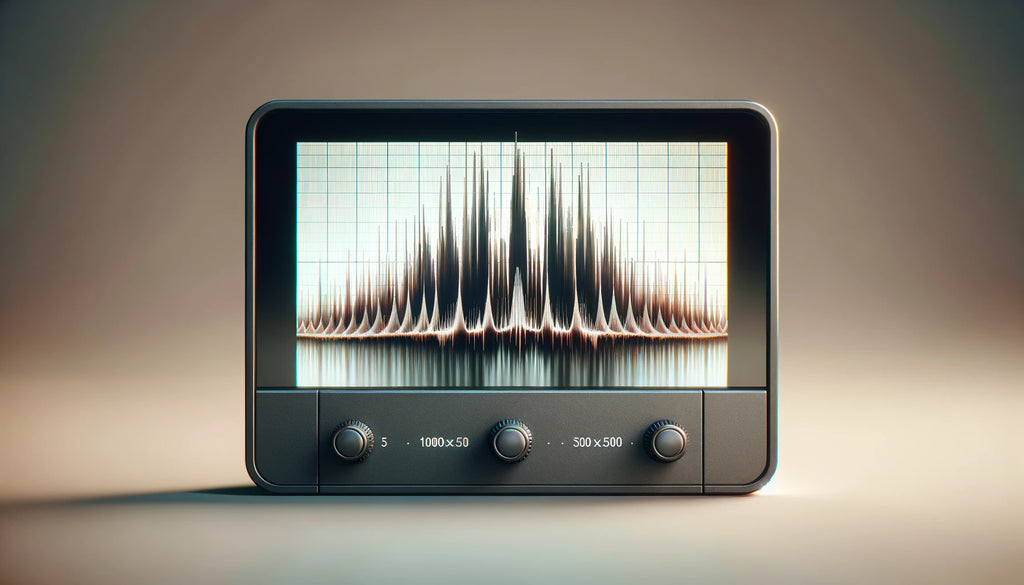Whether you're a casual listener or an audiophile, understanding the concept of impedance can help you make informed decisions when choosing headphones and ensure that you get the most out of your audio equipment. In this article, we'll dive deep into the world of headphone impedance, exploring its definition, importance, and how it affects various aspects of headphone performance.
Understanding Impedance in Headphones

What is Impedance?
Impedance, measured in ohms (Ω), is an essential characteristic of headphones that describes the device's resistance to the flow of electrical current. In simpler terms, it's a measure of how much the headphones resist the audio signal coming from your device. This resistance is not constant and can vary depending on the frequency of the signal.
The Importance of Impedance in Headphone Performance
Understanding impedance is crucial for achieving optimal headphone performance and compatibility with your audio source. Headphones with the correct impedance for your device will deliver the best possible sound quality, volume, and power efficiency. Mismatched impedance can lead to various issues, such as distortion, lack of volume, or even damage to your headphones or audio source.
When I started my career as a technician at a local repair shop, I encountered countless customers who were frustrated with their headphones' performance, not realizing that the issue stemmed from a mismatch in impedance. By educating them on this crucial aspect, I helped them find the perfect headphones for their needs and avoid future problems.
How Impedance Affects Sound Quality, Volume, and Power Requirements
Impedance plays a significant role in shaping the sound quality of your headphones. Lower impedance headphones (typically 16-32Ω) are easier to drive and can achieve higher volumes with less power. They're ideal for use with portable devices like smartphones and tablets, which have limited amplification capabilities. However, low impedance headphones are more susceptible to distortion at higher volumes and may not provide the same level of detail and clarity as their high impedance counterparts.
On the other hand, high impedance headphones (100Ω and above) require more power to achieve the same volume levels as low impedance models. They are best suited for use with dedicated amplifiers or high-end audio equipment that can provide the necessary power. The benefit of high impedance headphones is that they often offer a more accurate and detailed sound representation, with better control over the driver's movement and less distortion at higher volumes.
A great example of this is when I was working on a project in the studio with a fellow musician. We were using a pair of high impedance studio headphones (250Ω) connected to a professional headphone amplifier. The level of detail and clarity we experienced was unparalleled, allowing us to make precise adjustments to our mix and achieve the perfect sound. Had we been using low impedance headphones without proper amplification, we would have missed out on the nuances that made all the difference in our final product.
Impedance Ratings Explained

Understanding Impedance Measurements in Ohms (Ω)
Impedance ratings for headphones are typically measured in ohms (Ω), which is a unit of electrical resistance. The higher the impedance rating, the more resistance the headphones have to the flow of electrical current. Common impedance ratings for headphones range from 16Ω to 600Ω, with most consumer-grade headphones falling between 16Ω and 32Ω.
When I first started working as a technician, I found the concept of impedance quite daunting. However, as I gained more experience and knowledge, I realized that understanding impedance ratings is essential for matching headphones with the right audio equipment and achieving the best possible sound quality.
Low Impedance (16-32Ω) vs. High Impedance (100Ω+) Headphones
Low impedance headphones (16-32Ω) are designed to work well with portable devices like smartphones, tablets, and laptops. These devices have limited amplification capabilities, so low impedance headphones are easier to drive and can achieve sufficient volume levels without requiring additional amplification. They are also more sensitive to the audio signal, which means they can produce louder sounds with less power.
High impedance headphones (100Ω+), on the other hand, are engineered for use with more powerful audio equipment, such as dedicated headphone amplifiers, studio gear, or high-end home audio systems. These headphones require more power to drive them properly and achieve optimal performance. The benefit of high impedance headphones is that they often provide a more accurate and detailed sound representation, with better control over the driver's movement and less distortion at higher volumes.
Matching Headphone Impedance to Audio Equipment for Optimal Performance
To get the best performance from your headphones, it's crucial to match their impedance rating with the output impedance of your audio source. As a general rule, the output impedance of your audio device should be about 1/8th (or less) of your headphones' impedance. This ensures that the audio signal is not significantly altered by the interaction between the source and the headphones, resulting in optimal sound quality.
For example, if you have a pair of 32Ω headphones, your audio source should ideally have an output impedance of 4Ω or less. If the output impedance is too high relative to the headphone impedance, you may experience issues like reduced volume, lack of bass, or a "thin" sound.
In my experience, one of the most common mistakes people make is trying to use high impedance headphones with devices that aren't designed to drive them properly. This often leads to disappointment and frustration, as the headphones fail to deliver the expected sound quality. By understanding the importance of matching impedance ratings, you can avoid these issues and ensure that you're getting the best possible performance from your headphones.
Impedance and Power Efficiency

The Relationship Between Impedance and Power Requirements
Impedance and power requirements are closely related when it comes to headphones. Lower impedance headphones require less power to achieve a given volume level, while higher impedance headphones demand more power to reach the same volume.
This is because higher impedance headphones have a greater resistance to the flow of electrical current, which means they need a stronger signal (more power) to overcome that resistance and drive the headphone drivers effectively. Lower impedance headphones, on the other hand, allow the electrical current to flow more easily, requiring less power to produce sound.
Efficiency Comparison of Low and High Impedance Headphones
Low impedance headphones are generally more efficient than their high impedance counterparts. They can achieve higher volume levels with less power, making them ideal for use with portable devices that have limited amplification capabilities. This efficiency also means that low impedance headphones can help extend the battery life of your mobile devices, as they draw less power to operate.
High impedance headphones, while less efficient, offer benefits in terms of sound quality and accuracy. They provide better control over the driver's movement, resulting in less distortion and a more detailed sound representation. However, this comes at the cost of higher power requirements, which means you'll need a more powerful amplifier or audio source to drive them properly.
Battery Life Considerations for Different Impedance Levels in Wireless Headphones
When it comes to wireless headphones, impedance plays a significant role in determining battery life. Lower impedance headphones are more power-efficient, which means they can operate for longer periods on a single charge. This is especially important for true wireless earbuds, where battery life is often a key consideration for users.
Higher impedance wireless headphones, while offering better sound quality, may have shorter battery life due to their increased power requirements. This is something to keep in mind when choosing wireless headphones, as you'll need to balance your priorities between sound quality and battery life.
In my experience working with various wireless headphones, I've found that most manufacturers strike a balance between impedance and battery life to cater to the needs of the average consumer. However, if you're an audiophile who prioritizes sound quality above all else, you may be willing to accept a slightly shorter battery life in exchange for the improved performance of high impedance wireless headphones.
Impedance and Audio Source Compatibility

The Importance of Matching Headphone Impedance with Audio Source Output Impedance
Achieving the best possible sound quality from your headphones requires more than just considering the headphone's impedance rating. It's equally important to ensure that your headphones are compatible with the output impedance of your audio source. Mismatched impedance can lead to a range of issues that can negatively impact your listening experience.
The general rule of thumb is that the output impedance of your audio source should be about 1/8th (or less) of your headphones' impedance. This ratio ensures that the audio signal is not significantly altered by the interaction between the source and the headphones, resulting in optimal sound quality.
The Effects of Mismatched Impedance on Sound Quality and Volume
When the output impedance of your audio source is too high relative to your headphones' impedance, you may encounter several issues. One common problem is a reduction in volume, as the high output impedance can limit the amount of power delivered to your headphones. This can be particularly noticeable with low impedance headphones, which rely on a strong, low-impedance signal to achieve their full volume potential.
Mismatched impedance can also affect the frequency response of your headphones, leading to a change in sound quality. For example, if the output impedance is too high, you may experience a lack of bass response or a "thin" sound, as the low frequencies are not being properly driven. In some cases, you may also notice an increase in distortion, especially at higher volumes, as the headphones struggle to handle the altered audio signal.
Tips for Choosing Headphones Based on the Source Device's Output Impedance
When selecting headphones, it's essential to consider the output impedance of the devices you'll be using them with. If you primarily use portable devices like smartphones, tablets, or laptops, it's best to opt for low impedance headphones (16-32Ω) that can be easily driven by these devices. Low impedance headphones will ensure that you can achieve good volume levels and sound quality without the need for additional amplification.
If you have a dedicated headphone amplifier or high-end audio equipment with a low output impedance, you can consider high impedance headphones (100Ω+) to take advantage of their superior sound quality and accuracy. These headphones will require more power to drive them properly, but the improved performance can be well worth it for audiophiles and critical listeners.
When in doubt, consult the specifications of your audio source devices to determine their output impedance, and choose headphones with an impedance rating that is at least 8 times higher. This will help ensure that you're getting the best possible performance from your headphones, regardless of the audio source you're using.
Impedance and Sound Signature

How Impedance Influences Sound Characteristics
Impedance plays a significant role in shaping the sound characteristics of headphones, influencing factors such as bass response, treble clarity, and overall sound balance. Low impedance headphones (16-32Ω) tend to have a more pronounced bass response, as they allow more current to flow through the drivers, resulting in stronger low-frequency vibrations. This can be appealing for listeners who enjoy a warm, bass-heavy sound signature.
High impedance headphones (100Ω+), on the other hand, often exhibit better treble clarity and a more balanced sound profile. The higher resistance to current flow allows for greater control over the driver's movement, reducing distortion and improving the accuracy of high-frequency reproduction. This can lead to a more detailed and analytical sound that appeals to audiophiles and critical listeners.
Impedance's Role in Shaping the Frequency Response of Headphones
The frequency response of a pair of headphones refers to how well they reproduce different frequencies across the audible spectrum. Impedance can influence this response by affecting the interaction between the headphones and the audio source.
Low impedance headphones are more susceptible to variations in the audio source's output impedance, which can lead to changes in the frequency response. For example, if the output impedance is too high relative to the headphone impedance, you may experience a roll-off in the bass frequencies, resulting in a thinner, less impactful sound.
High impedance headphones are generally less affected by variations in the audio source's output impedance, as their higher resistance helps maintain a more consistent frequency response. This is one of the reasons why high impedance headphones are often preferred by audio professionals and enthusiasts who demand the most accurate sound reproduction.
Finding the Right Impedance for Your Preferred Sound Profile and Listening Preferences
Ultimately, the right headphone impedance for you will depend on your personal sound preferences and the type of music you listen to. If you enjoy a warm, bass-heavy sound and primarily use portable devices, low impedance headphones (16-32Ω) may be the best choice. These headphones will provide a fun, engaging listening experience that emphasizes the low frequencies.
If you prioritize accuracy, detail, and a balanced sound profile, high impedance headphones (100Ω+) may be more suitable. These headphones excel at reproducing the nuances in your music, making them ideal for critical listening and analytical tasks. However, keep in mind that you'll need a powerful amplifier or audio source to drive them properly.
In my experience, it's also important to consider the specific sound signature of the headphones you're interested in, as impedance is just one factor that contributes to their overall performance. Reading reviews, consulting frequency response graphs, and auditioning headphones in person can help you find the perfect pair that matches your preferred sound profile and listening preferences.
Impedance and Headphone Types

Impedance Variations in Different Headphone Designs
Headphone impedance can vary significantly depending on the design and intended use of the headphones. In-ear, on-ear, and over-ear headphones often have different impedance ranges, each optimized for specific applications and listening preferences.
In-ear headphones, also known as earbuds or in-ear monitors (IEMs), typically have low impedance ratings (16-32Ω). This is because they are designed to be used with portable devices like smartphones and tablets, which have limited amplification capabilities. The low impedance allows these headphones to achieve good volume levels and sound quality without requiring additional amplification.
On-ear and over-ear headphones can have a wider range of impedance ratings, from low (32Ω) to high (250Ω or more). The impedance of these headphones is often determined by their intended use and target audience. Lower impedance on-ear and over-ear headphones are generally designed for casual listening and use with portable devices, while higher impedance models are geared towards audiophiles and professional users who have access to dedicated amplification equipment.
Ideal Impedance Ranges for Various Headphone Types
When selecting headphones, it's important to consider the ideal impedance range for each type to ensure optimal performance and compatibility with your audio source devices.
For in-ear headphones, the ideal impedance range is typically between 16Ω and 32Ω. This range allows for good efficiency, volume, and sound quality when used with portable devices like smartphones and tablets.
On-ear and over-ear headphones have a broader range of ideal impedances, depending on their intended use:
- For casual listening and use with portable devices, look for headphones with impedance ratings between 32Ω and 80Ω. These headphones will provide a good balance of efficiency, sound quality, and compatibility with most consumer-grade audio sources.
- For audiophile-level performance and use with dedicated amplifiers, consider headphones with impedance ratings of 100Ω or higher. These high impedance headphones offer superior sound quality, accuracy, and detail, but require more powerful amplification to drive them properly.
Considerations for Impedance in Wireless and Noise-Canceling Headphones
Wireless and noise-canceling headphones have additional factors to consider when it comes to impedance. In wireless headphones, the impedance of the headphone drivers can impact battery life, as lower impedance drivers are more power-efficient and can help extend the playback time on a single charge.
Noise-canceling headphones, whether wired or wireless, often have built-in amplification to power the active noise cancellation circuitry. This can affect the optimal impedance range for these headphones, as the built-in amplifier may have specific requirements for achieving the best noise cancellation performance and sound quality.
When choosing wireless or noise-canceling headphones, it's essential to consider the manufacturer's recommendations for impedance and compatibility with your audio sources. In general, lower impedance ratings (32Ω-80Ω) are more common in these types of headphones to ensure good efficiency, battery life, and compatibility with a wide range of devices.
Impedance in Real-World Applications

Portable Devices and Low Impedance Headphones
In today's mobile-centric world, portable devices like smartphones and tablets have become the primary audio sources for many people. These devices are designed to work best with low impedance headphones (16-32Ω), as they have limited built-in amplification capabilities.
When using low impedance headphones with portable devices, you can expect good volume levels, efficient power consumption, and compatibility across a wide range of devices. This makes low impedance headphones an ideal choice for on-the-go listening, whether you're commuting, exercising, or just enjoying your favorite music or podcasts.
Home Audio Systems and High Impedance Headphones
For home audio setups, where dedicated amplifiers and high-end audio equipment are more common, high impedance headphones (100Ω+) can offer a superior listening experience. These headphones are designed to take full advantage of the power and quality of home audio systems, delivering exceptional sound quality, detail, and accuracy.
When paired with a high-quality headphone amplifier or integrated amplifier with a dedicated headphone output, high impedance headphones can provide an immersive and engaging listening experience that rivals the best speaker-based systems. They are an excellent choice for critical listening, music appreciation, and enjoying high-resolution audio formats.
Professional Studio Environments and the Role of Impedance Matching
In professional studio environments, where accuracy and consistency are paramount, impedance matching plays a crucial role in ensuring optimal performance from headphones and other audio equipment. Studio engineers and producers rely on high impedance headphones (250Ω+) for their ability to reproduce sound with minimal distortion, excellent transient response, and a balanced, accurate frequency response.
To achieve the best results, studio professionals use dedicated headphone amplifiers with calibrated output impedances that are carefully matched to the impedance of their headphones. This ensures that the headphones are driven properly, maximizing their performance potential and allowing for precise monitoring and critical listening tasks.
Proper impedance matching is also essential when using headphones in conjunction with other studio equipment, such as mixing consoles and audio interfaces. By maintaining consistent impedance relationships throughout the signal chain, engineers can minimize signal loss, prevent unwanted noise and distortion, and ensure that the audio remains true to the source material.
In my experience working in studio environments, I've found that investing in high-quality, high impedance headphones and properly matching them with the right amplification equipment can make a significant difference in the accuracy and reliability of the monitoring process. This, in turn, leads to better mixes, more informed decisions, and ultimately, higher-quality final productions.
Impedance Myths Debunked

Addressing Common Misconceptions About Headphone Impedance
There are many misconceptions and myths surrounding headphone impedance that can lead to confusion and misinformation. One of the most common myths is that higher impedance always equates to better sound quality. While it's true that many high-end headphones have high impedance ratings, this doesn't necessarily mean that all high impedance headphones sound better than their low impedance counterparts.
In reality, the relationship between impedance and sound quality is more complex and depends on a variety of factors, including the headphone design, driver technology, and the quality of the audio source and amplification equipment.
Clarifying the Relationship Between Impedance and Sound Quality
Another common misconception is that impedance directly affects sound quality. While impedance can influence certain aspects of a headphone's performance, such as its ability to handle high volumes without distortion, it is not the sole determinant of sound quality.
Factors like driver design, materials, and tuning have a more significant impact on the overall sound signature and quality of a pair of headphones. A well-designed low impedance headphone can easily outperform a poorly designed high impedance model in terms of sound quality and listener enjoyment.
Separating Fact from Fiction in Impedance Discussions
It's essential to separate fact from fiction when discussing headphone impedance. Here are a few key points to keep in mind:
- High impedance does not always mean better sound quality. While many high-end headphones have high impedance ratings, this is not a guarantee of superior performance.
- Low impedance headphones can offer excellent sound quality when paired with the right audio source and amplification equipment.
- Impedance is just one factor among many that contribute to a headphone's overall performance and sound signature.
- The ideal impedance for a pair of headphones depends on the intended use case, the audio source, and personal listening preferences.
By understanding these facts and dispelling common myths, you can make more informed decisions when selecting headphones and avoid falling for marketing hype or misinformation.
FAQ
Do higher impedance headphones always sound better?
No, higher impedance headphones do not always sound better. While many high-end headphones have high impedance ratings, this is not a guarantee of superior sound quality. Other factors, such as driver design and tuning, play a more significant role in determining the overall sound performance.
What is a good impedance level for everyday listening?
For everyday listening with portable devices like smartphones and tablets, low impedance headphones (16-32Ω) are generally the best choice. They are easy to drive, provide good volume levels, and are compatible with a wide range of devices.
Is it better to have lower or higher impedance for portable devices?
For portable devices, lower impedance headphones (16-32Ω) are usually better. These devices have limited built-in amplification, so low impedance headphones are more easily driven and can achieve good volume levels and sound quality without requiring additional amplification.
Does impedance affect sound quality directly?
Impedance does not directly affect sound quality. While it can influence certain aspects of a headphone's performance, such as its ability to handle high volumes without distortion, other factors like driver design, materials, and tuning have a more significant impact on the overall sound signature and quality.
How important is impedance when choosing headphones?
Impedance is an important factor to consider when choosing headphones, as it determines the headphones' compatibility with your audio source devices and can influence certain aspects of their performance. However, it should not be the sole deciding factor, as other elements like sound signature, comfort, and build quality are equally important.
What is the most common headphone impedance for consumer-grade headphones?
The most common impedance range for consumer-grade headphones is 16-32Ω. This range is well-suited for use with portable devices and provides a good balance of efficiency, volume, and sound quality.
Why do some high-end headphones have high impedance?
Some high-end headphones have high impedance ratings (100Ω+) because they are designed for use with dedicated amplification equipment, such as headphone amplifiers or high-end audio systems. These headphones can offer superior sound quality, detail, and accuracy when paired with the right equipment, but require more power to drive them properly.
Conclusion
In conclusion, understanding headphone impedance is crucial for achieving the best possible listening experience. By grasping the concept of impedance and how it relates to factors like sound quality, power efficiency, and compatibility with different audio sources, you can make informed decisions when selecting headphones and ensure that you get the most out of your audio equipment.
Throughout this article, we've explored the various aspects of headphone impedance, from its definition and importance to its impact on sound signature and real-world applications. We've also debunked common myths and misconceptions surrounding impedance, helping you separate fact from fiction in your quest for the perfect headphones.
Ultimately, the right headphone impedance for you will depend on your personal listening preferences, the devices you use, and the type of music you enjoy. By considering these factors and applying the knowledge you've gained from this article, you can find the ideal headphones that deliver the sound quality, comfort, and compatibility you need for an unparalleled listening experience.
So, the next time you're in the market for a new pair of headphones, remember the importance of impedance and how it can shape your audio journey. With this knowledge at your fingertips, you're well on your way to discovering the perfect headphones that will take your music enjoyment to new heights.



Share:
10 best headphones for Dell laptops
The 10 Best Headphones for Dancing